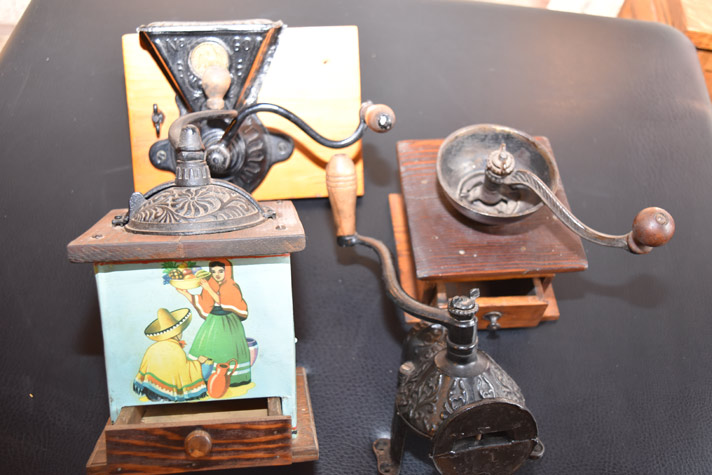Speaking of Antiquing – February 2018
Coffee is a beverage which the whole world consumes. Roasting, grinding, and serving are subjects that could be discussed at length, but I want to focus on grinding.
When coffee was introduced as a beverage in the 1200’s by the Arabians, small amounts of beans were roasted at meal times and ground between two small millstones for single servings. Later, wheat mills used by the Romans were adapted for grinding larger amounts.
Coffee grinders have evolved from a mortar and pestle type to today’s high-speed machines that can grind 300 pounds or more instantly.
American coffee grinders of the 19th century were made of cast iron grinding wheels and wooden hoppers to catch the grind, and were mounted on the wall, floor, or counter top. Enterprise Manufacturing of Philadelphia made large, heavy, cast iron, mounted grinders for grocers, retailers and wholesalers.
If looking to collect American-made grinders look for makers such as Imperial, Favorite, and None-Such, Arcade King, Enterprise, Charles Parker & Co., Fray & Clark, Logan & Strobridge, to name a few. The first American patent for a coffee grinder was granted to Thomas Bruff Sr. in 1798, for a wall-mounted mill.
In England, the first patent was granted to Richard Dearman, for an improved grinder in 1789. Kenrick & Sons made box grinders and labeled them with a brass nameplate. While in France, Peugeot Freres made metal and cast-iron box grinders with wooden handles that were decorative and practical.
The Turks, famous for their fine ground, rich bodied espresso coffee, were grinding beans in cylindrical hand-held mills that resemble today’s pepper grinders.
American cowboys had coffee grinders mounted to the chuck wagon, and hand-held box grinders came westward in wagon trains with the pioneers. If the early settlers could not get coffee, they ground acorns and added chicory to steep for a hot drink that they called “coffee.”
In Holland, porcelain delft grinders, a fixture in most homes, were cheery, hand-painted, wall-mounted units with a glass collecting cup.
Oriental grinders were made of teakwood and brass, some with ivory inlays that were quite exquisite.
Coffee grinders are not hard to find and are very good to have in case you accidentally pick up a bag of beans instead of ground coffee like I did last week. My inherited grinder has no drawer for the catching, but is quite functional and made my morning brew quite enjoyable. Box grinders can easily be taken along on a camping trip, and would make a thoughtful gift for your friends who live off-grid.
Don’t get a wooden box grinder wet, as the wood can warp, and be sure to clean it with a soft brush or rough rag to make your find useable. Shine up the cast iron parts with a soft brush also and lightly “season” it with minimal olive oil and a wipe down.
Pickety Place carries a wide selection of vintage grinders, brewers, and serving items for your coffee enjoyment.

 Margaret Barns is co-owner of Pickety Place Antiques & Collectibles located at 130 N. 4th Street in Jacksonville. LIKE them on
Margaret Barns is co-owner of Pickety Place Antiques & Collectibles located at 130 N. 4th Street in Jacksonville. LIKE them on